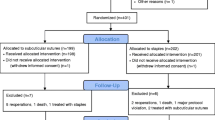Abstract
Purpose
This study was performed to investigate the effect of subcuticular sutures on the incidence of incisional surgical site infection (SSI) after closure of a diverting stoma.
Methods
The study was carried out as a retrospective analysis of prospectively collected data from 51 patients who underwent closure of diverting stoma following resections of lower rectal cancer between January 2008 and December 2008. This study attempted to determine whether there was an association between the type of skin closure and the incidence of incisional SSI. Moreover, risk factors for incisional SSI after closure of diverting stoma were identified using a multivariate analysis.
Results
An incisional SSI occurred in 12 of the 51 patients (23.5%). The rate of incisional SSI with subcuticular sutures was 11.1% (3/27) in comparison to 37.5% (9/24) with transdermal suture and skin stapler. A subcuticular skin closure was the only favorable factor that was significantly associated with a lower incidence of incisional SSI (odds ratio: 0.19; 95% confidence interval: 0.04–0.92).
Conclusions
A subcuticular skin closure has a protective effect against incisional SSI after closure of diverting stoma. A larger study is necessary to further define the role of subcuticular suture on the prevention of incisional SSI in cases of gastrointestinal surgery.
Similar content being viewed by others
References
Riesener KP, Lehnen W, Hofer M, Kasperk R, Braun JC, Schumpelick V. Morbidity of ileostomy and colostomy closure: impact of surgical technique and perioperative treatment. World J Surg 1997;21:103–108.
Hackam DJ, Rotstein OD. Stoma closure and wound infection: an evaluation of risk factors. Can J Surg 1995;38:144–148.
Lavery IC. Technique of colostomy construction and closure. In: Baker RJ, Fischer JE, editors. Mastery of surgery. 4th ed. Philadelphia: Lippincott Williams & Wilkins; 2001. p. 1480–1489.
Sutton CD, Williams N, Marshall LJ, Lloyd G, Thomas WM. A technique for wound closure that minimized sepsis after stoma closure. ANZ J Surg 2002;72:766–767.
Johnson RG, Cohn WE, Thurer R, McCarthy JR, Sirois CA, Weintraub RM. Cutaneous closure after cardiac operations. A controlled, randomized, prospective comparison of intradermal versus staple closures. Ann Surg 1997;236:606–612.
Shetty AA, Kumar VS, Morgan-Hough C, Georgeu GA, James KD, Nicholl JE. Comparing wound complication rates following closure of hip wounds with metallic skin staples or subcuticular vicryl suture: a prospective randomized trial. J Orthop Surg 2004;12:191–193.
Johnson A, Young D, Reilly J. Caesarean section surgical site infection surveillance. J Hosp Infect 2004;64:30–35.
Obermair A, Crandon A, Perrin L, Walsh T, Carrazo M, Nicklin J. Randomized trial of skin closure after laparotomy for gynaecological surgery. ANZ J Surg 2007;77:460–463.
Keating J, Kelly EW, Hunt I. Save the skin and improve the scar. A simple technique to minimize the scar from a temporary stoma. Dis Colon Rectum 2003;46:1428–1429.
Mangram AJ, Horan TC, Pearson ML, Silver LC, Jarvis WR. Guideline for prevention of surgical site infection, 1999. Infect Control Hosp Epidemiol 1999;20:247–278.
Lawrence WT. Wound healing biology and its application to wound management. In: O’Leary JP, editor. The physiologic basis of surgery. 3rd ed. Philadelphia: Lippincott Williams & Wilkins; 2002. p. 107–132.
Meiring L, Cilliers K, Barry R, Nel CJ. A comparison of a disposable skin stapler and nylon sutures for wound closure. S Afr Med J 1982;62:371–372.
Murphy M, Prendergast P, Rice J. Comparison of clips versus sutures in orthopaedic wound closure. Eur J Orthop Surg Traumatol 2004;14:16–18.
Sugawara Y. The subcutaneous suture closure to reduce surgical site infection (in Japanese). J Jpn Soc Surg Infect 2009;6:273–276.
Angelini GD, Butchart EG, Armistead SH, Brechenridge IM. Comparative study of leg wound skin closure in coronary artery bypass graft operations. Thorax 1984;39:942–945.
Li J, Chen J, Kirsner R. Pathophysiology of acute wound healing. Clinic Dermatol 2007;25:9–18.
Singer AJ, Clark RAF. Cutaneous wound healing. New Engl J Med 1999;341:738–745.
Kobayashi S, Gotohda N, Nakagohri T, Takahashi S, Konishi M, Kinoshita T. Risk factors of surgical site infection after hepatectomy for liver cancers. World J Surg 2009;33:312–317.
Yoshida J, Shinohara M, Ishikawa M, Matsuo K. Surgical site infection in general and thoracic surgery: surveillance of 2663 cases in a Japanese Teaching Hospital. Surg Today 2006;36:114–118.
Kaiser AM, Israelit S, Klaristenfeld D, Slevindoss P, Vukasin P, Ault G, et al. Morbidity of ostomy takedown. J Gastrointest Surg 2008;12:437–441.
Kobayashi M, Inoue Y, Mohri Y, Miki C, Kusunoki M. Implementing a standard protocol to decrease the incidence of surgical site infections in rectal cancer surgery. Surg Today 2010;40:326–333.
Cardo DM, Falk PS, Mayhall CG. Validation of surgical wound surveillance. Infect Control Hosp Epidemiol 1993;14:211–215.
Author information
Authors and Affiliations
Rights and permissions
About this article
Cite this article
Kobayashi, S., Ito, M., Sugito, M. et al. Association between incisional surgical site infection and the type of skin closure after stoma closure. Surg Today 41, 941–945 (2011). https://doi.org/10.1007/s00595-010-4405-y
Received:
Accepted:
Published:
Issue Date:
DOI: https://doi.org/10.1007/s00595-010-4405-y




